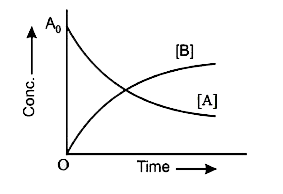At the point of intersection of the two curves shown for the reaction

A→nB time →
then concentration of B is given by :
nA02
A0n−1
nA0n+1
(n−1)(n+1)A0
The correct Answer is:C
Step by step video & image solution for At the point of intersection of the two curves shown for the reaction A rarr nB " time " rarr then concentration of B is given by : by Chemistry experts to help you in doubts & scoring excellent marks in Class 12 exams.
Updated on:21/07/2023Topper's Solved these Questions
- Chemical KineticsBOOK - MOTIONCHAPTER - Chemical KineticsEXERCISE - Exercise - 2 (Level-I) (Experimental Method to calculate order)
4 Videos
- Chemical KineticsBOOK - MOTIONCHAPTER - Chemical KineticsEXERCISE - Exercise - 2 (Level-I) (Arrhenius equation)
11 Videos
- Chemical KineticsBOOK - MOTIONCHAPTER - Chemical KineticsEXERCISE - Exercise - 2 (Level-I) (Introduction, Rate of reaction, Factor affecting rate of reaction, Effect of)
14 Videos
- CHEMICAL EQUILIBRIUMBOOK - MOTIONCHAPTER - CHEMICAL EQUILIBRIUMEXERCISE - Exercise - 4
20 Videos
- CLASSROOM PROBLEMS BOOK - MOTIONCHAPTER - CLASSROOM PROBLEMS EXERCISE - Electrochemistry
22 Videos
Similar Questions
At the point of intersection of the two curves shown the concentration of B is given by _______for the first reaction A→nB.

View SolutionFor the reaction A+B→C+D, doubling the concentration of both the reactants increases the reaction rate by 8 times and doubling the initial concentration of only B ismply doubles the reaction rate. What is the rate law for the reaction ?
View Solution
Knowledge Check
At the point of intersection of the two curves shown, the conc. of B is given by ……… for, A→nB:
 AnA02BA0n−1CnA0n+1D(n−1n+1)A0
AnA02BA0n−1CnA0n+1D(n−1n+1)A0At the point of intersection of the two curves shown, calculate the concentration of B in the first order reaction A→nB.
 AnA02BA0n−1CnA0n+1D(n−1n=1)A0
AnA02BA0n−1CnA0n+1D(n−1n=1)A0At the given point of intersection of the two curves shown concentration of B is given by ………for, A=3B
 A4/3A0B3/4A0C1/3A0D1/4A0
A4/3A0B3/4A0C1/3A0D1/4A0
At the point of intersection of the two curves shown, the conc.of B is given by….. ….. ……….for, A→nB

View SolutionFor the reaction A+B→C+D The variation of the concentration of the products is given by the curve

View SolutionFor the reaction, A+B→C+D. The variation of the concentration of the products is given by the curve.

View SolutionFor the reaction, A+B→C+D. The variation of the concentration of the products with time is given by the curve:

View SolutionFor the hypothetical reaction 2A→3C , the reaction rate r in terms of the rate of change of the concentration is given by
View Solution
